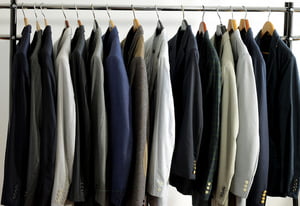If you spent last winter shivering, or trying to distinguish your own coat from a sea of other black winter coats at parties, it might be time for something new. A winter coat normally represents a larger investment than other clothing, so follow these guidelines for a piece that will stay in your wardrobe for years to come.
Warmth is the most important thing to consider and is often the most neglected area. There is no need to dress in a down filled monstrosity to keep warm, but there is also no need to spend months shivering in an insufficient winter coat. Wool is often the best material for a warm winter coat, it will breath while helping you retain your own body heat. The length will also determine how warm you are in it. Also, make sure that your winter coat will accommodate several layers underneath it and still button properly.
The type of coat that will be the most versatile for you will vary with your own lifestyle. In general, a below the knee, fitted, single-breasted wool winter coat will work with pants and skirts on a variety of occasions. This type of winter coat is almost universally flattering and can be found in almost every store and every price point. If you only wear pants, or prefer a sportier style, a pea coat is another good option, but make sure that it is cut close to the body. Do not, however, make the mistake of thinking that a jacket that is really sports apparel is a suitable everyday winter coat.
The color and print of your winter coat is also an important consideration. If you want to a winter coat for more than one year without looking dated, stay away from large, bold prints and overly trendy colors. This does not mean that a black coat is your only option. Look for deep plums, blues, and browns that might flatter you. Also consider a muted, small plaid in neutral colors. Think carefully what colors look good on you, and what colors will complement the rest of your wardrobe.
If you’re on a budget, try to buy winter coats at the end of the season for the best deals. Most classic winter coats have a similar silhouette year to year; these are the pieces to invest in. Also look at vintage and consignment shops for a winter coat that might work for you. Often vintage coats are better made than their contemporaries. Before buying, check very carefully for any moth holes or stains. These deficiencies can seldom be repaired. However, things like buttons or a worn or missing belt can easily be replaced for a few dollars.
Once you have found your new winter coat, be sure to take good care of it. Dry cleaning a few times during the season is a good idea, and be particularly vigilant if your winter coat is a light color. Always hang your winter coat on a quality hanger that will preserve the shape of the shoulders. At the end of the season, check for loose buttons and small tears, especially tears in the lining. When you go to have the piece dry cleaned, point out these problems and have them repaired. After it returns from the dry cleaner, store it outside the plastic dry cleaning bag, in a breathable container. Be sure to take precautions against moths if they are common in your area.





